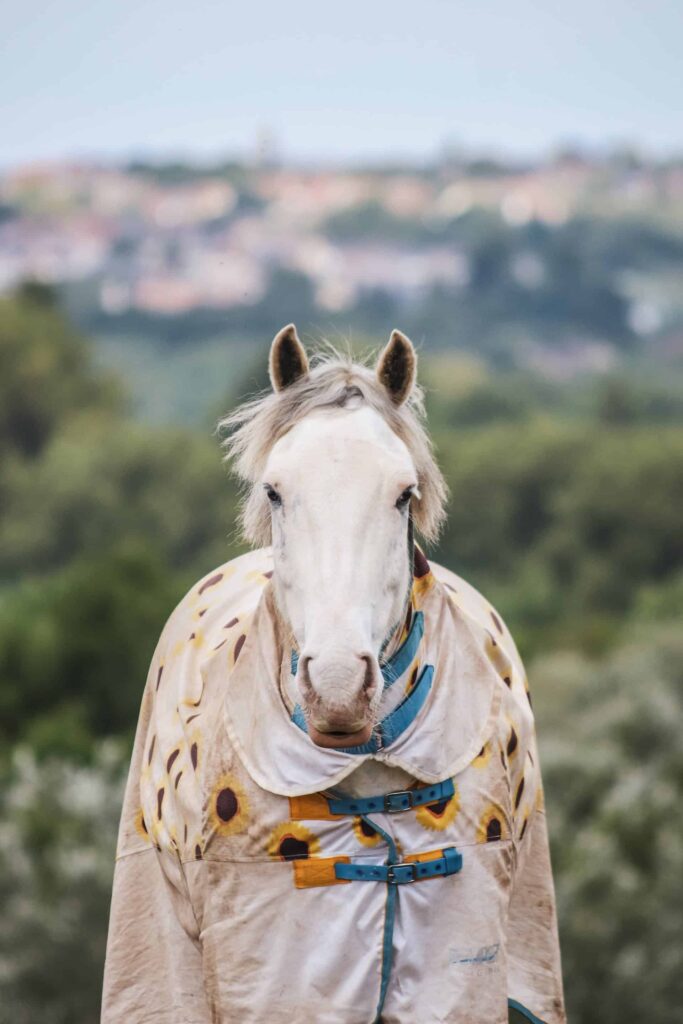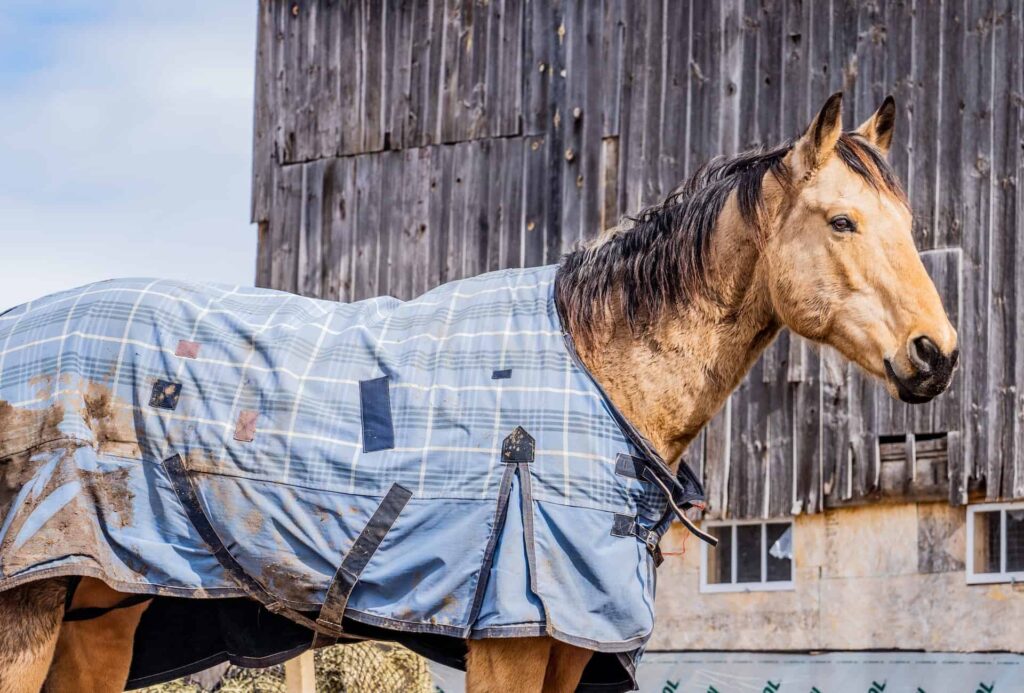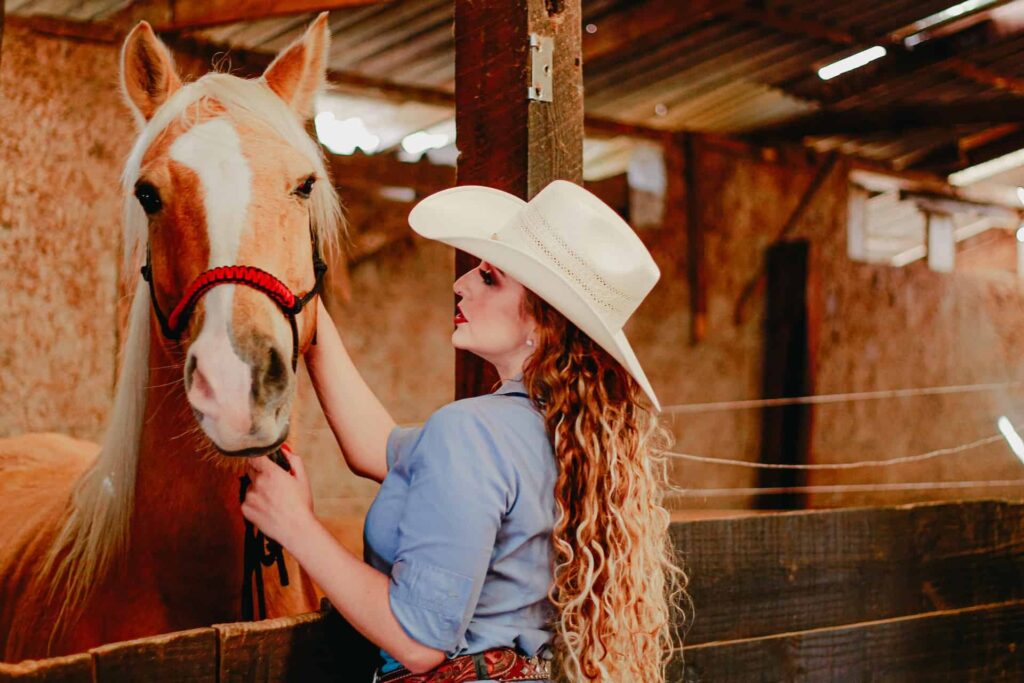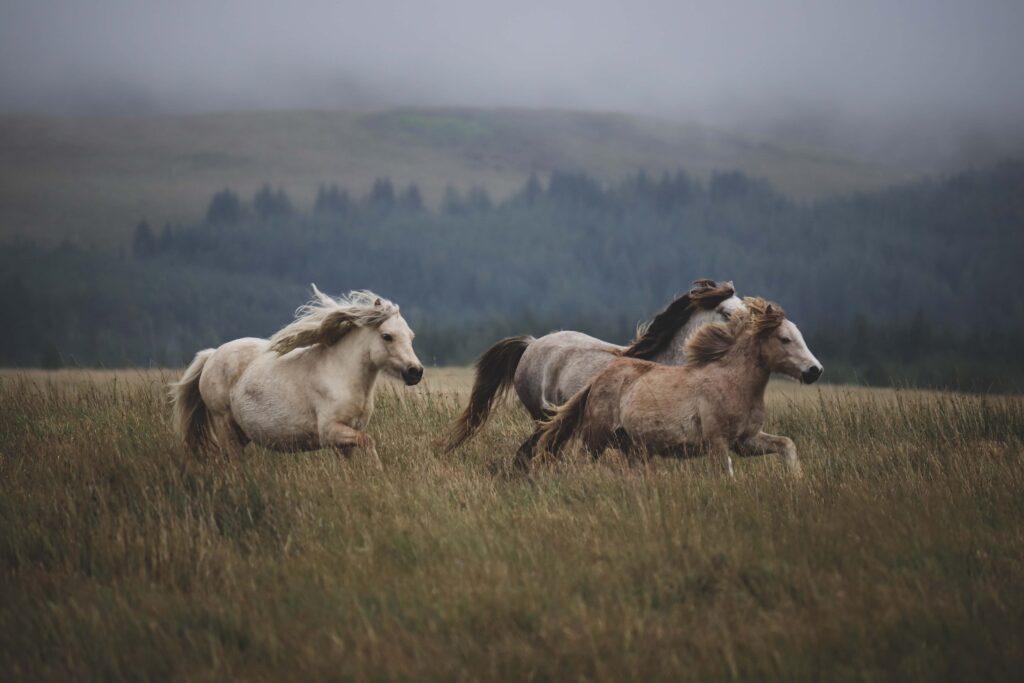Measuring a horse blanket is an important aspect of horse care, ensuring your equine friend stays protected from the elements. A well-fitted horse blanket can enhance your horse’s overall well-being and provide comfort during harsh weather conditions. Knowing how to properly measure for a horse blanket involves understanding the basic principles of horse blanket design, as well as considering factors such as climate, seasonality, and your horse’s specific requirements.
There are various types of horse blankets available on the market, each designed to cater to the specific needs and preferences of both the horse and the owner. Measuring for a horse blanket involves identifying key measurements and using appropriate tools and techniques, which can ensure that the blanket fits well and provides optimal protection. A properly fitted horse blanket can also reduce the risk of chafing, injuries, or discomfort caused by blankets that are too tight or too loose.
Key Takeaways
- Properly measuring for a horse blanket enables a comfortable and secure fit for your horse
- Considering climate, seasonality, and style ensures a suitable blanket choice for various situations
- Regular care, maintenance, and assessment of horse blankets promote a healthy and well-protected horse
Understanding Horse Blanket Basics
Horse blankets play a crucial role in keeping horses protected in various weather conditions. They come in different styles and are designed for use in the stable or as turnout blankets for outdoor use. This section will help you better understand horse blanket basics, which will make it easier to find the right one for your horse.
When it comes to horse blankets, there are two main types: stable blankets and turnout blankets. Stable blankets are meant to be worn indoors and are typically made of thick, quilted material that provides warmth. Turnout blankets, on the other hand, are designed for outdoor use and are crafted from waterproof and breathable materials to protect the horse from rain, snow, and wind.
In addition to the two primary styles, there are also horse sheets and specialty blankets. Horse sheets are lightweight coverings that serve to keep the horse clean and protect them from insects, while specialty blankets are designed for specific purposes like fly protection or therapeutic benefits.
To choose the right blanket for your horse, it is important to consider the climate and your horse’s specific needs. The thickness of the blanket, its breathability, and its intended purpose will all play a role in your decision-making.
When it comes to sizing a horse blanket, it’s crucial to ensure that the fit is comfortable and secure. To determine the correct size, measure your horse from the center of the chest, across the widest part of the shoulder, and to the furthest point of the buttocks. This will give you the blanket size in inches. Keep in mind that not all manufacturers use the same sizing, so always refer to the manufacturer’s sizing chart for the most accurate fit.
Ultimately, understanding horse blanket basics will help you choose the appropriate type and size of blanket for your horse’s needs. The right blanket can make a considerable difference in your horse’s health during challenging weather conditions.
Recognizing the Importance of a Well-Fitting Blanket
A well-fitting horse blanket aids the comfort and security of the horse. Ensuring a proper fit not only contributes to the horse’s well-being but also prevents potential issues that may arise from an ill-fitting blanket.
One significant factor to consider is the avoidance of rubbing and chafing. A properly fitting blanket helps to minimize these discomforts by evenly distributing pressure across the horse’s body. This allows the horse to move freely without the risk of creating sore spots or causing coat damage.
Sagging and bunching are other problems associated with poorly fitted blankets. Blankets that are too large or loose can lead to sagging, which can impact the horse’s mobility and potentially cause entanglement. Conversely, blankets that are too tight might bunch up, causing pressure points and discomfort for the horse.
A well-fitting blanket also provides a sense of security for the horse. Horses are susceptible to changes in temperature and weather conditions. A properly fitting blanket ensures that the horse remains warm and protected, while at the same time, allowing adequate airflow to prevent overheating.
Investing time and effort into finding a well-fitting horse blanket is crucial for maintaining the comfort, well-being, and security of the horse. By taking the proper measurements and considering the necessary factors, horse owners can provide their equine companions with a properly fitted blanket that contributes to their health and happiness.

Identifying Key Measurements for Horse Blankets
When selecting a horse blanket, it is crucial to accurately measure your horse’s size to ensure a comfortable and secure fit. This section will guide you through the process of measuring your horse for a blanket, focusing on three measurements: length, width, and height.
Length Measurement
The length measurement is the most critical aspect of choosing a horse blanket, as this determines the overall fit and coverage. To measure the length, follow these steps:
- Stand your horse on a level surface and ensure they are standing square.
- Use a measuring tape and start from the center of the chest (where the neck meets the body).
- Extend the tape along the side of the horse, following the contour of the body.
- Stop the tape at the tail, just where the hindquarters begin.
- Record the measurement for your reference.
Width Measurement
The width measurement helps in selecting the appropriate blanket size to cover your horse’s barrel or girth area. To measure the width, follow these steps:
- Position your horse on a level surface, standing square.
- Locate the widest part of the horse’s barrel (usually around the mid-section).
- Place the measuring tape on one side of the barrel, starting at the horse’s spine.
- Extend the tape across their barrel to the opposite side, hugging the contours.
- Record the measurement for your reference.
Height Measurement
While not mandatory for choosing a horse blanket, knowing the height of your horse can assist in refining the fit of the blanket, especially at the neck area. To measure the horse’s height, follow these steps:
- Ensure your horse is on a level surface, standing square.
- Locate the highest part of the withers (the ridge between the shoulder blades).
- Using a measuring tape, measure from the highest point of the withers to the ground.
- Record the measurement for your reference.
By obtaining these key measurements – length, width, and height – you will have the necessary information to confidently select the appropriate size horse blanket. Always consult the sizing charts provided by the blanket manufacturer, as size variations may exist between different brands and styles.
Tools and Techniques for Measuring Horse Blankets
When fitting a horse blanket, ensure proper measurements for the best comfort and protection for your horse. This section outlines the tools and techniques needed for measuring horse blankets accurately and effectively.
Using a Measuring Tape
The most common and effective tool for measuring a horse blanket is a measuring tape. Using a soft measuring tape or a flexible tape measure is recommended, as it easily conforms to the contours of your horse’s body, providing accurate measurements.
To measure your horse:
- Stand your horse on level ground.
- Start from the center of your horse’s chest.
- Wrap the tape measure around the widest part of the horse’s body, typically around the shoulder and barrel.
- Continue to the center of the tail.
- Record the measurement in inches or centimeters.
Remember to measure your horse without any additional padding or saddlery, to ensure you get accurate measurements.
Measuring on Level Ground
Measuring your horse on level ground is crucial for obtaining precise measurements. Uneven or sloping ground can cause your horse to shift their weight, affecting the accuracy of your measurements. A flat, firm surface is ideal for proper measurement.
Before you begin measuring, ensure your horse is standing squarely, with all four legs evenly spaced and hooves flat on the ground. Keep your horse calm and relaxed, as tenseness could also lead to inconsistent measurements.
In summary, use a soft or flexible measuring tape to measure your horse from the center of its chest to the center of its tail while standing on level ground. Following these techniques will ensure an accurate fit for your horse’s blanket.
Supplementary Measurements to Consider
When measuring for a horse blanket, here’s what to consider to ensure the blanket fits well. These include the horse’s weight, shoulder size, age, and breed characteristics.
Weight plays a significant role in determining the right size of a horse blanket. A blanket that is too small or tight may restrict movement and cause discomfort, while a loose or oversized blanket might slide off or lead to rubbing and irritation. Weigh your horse accurately, ideally using a weight tape or a scale, ensuring the blanket’s adequate fit based on the specific weight range it is designed for.
The shoulder area is another crucial factor to consider when measuring a horse blanket. Horses with broader shoulders may require a larger blanket or a design specifically made to accommodate wide shoulders. To measure your horse’s shoulders, use a soft tape measure across the widest point to track the shoulder circumference. This information will help you choose a blanket with sufficient room for the shoulders to move freely without rubbing or bunching.
Age is an important factor to consider, as younger and older horses may have different requirements. Foals and growing horses may need adjustments or replacement blankets as they continue to develop. On the other hand, senior horses might require blankets with extra support or padding.
Breed characteristics can affect the fit of a horse blanket, as some breeds have distinct features, such as a longer back or a more muscular frame. Research your horse’s specific breed and be aware of any particular blanket preferences or concerns.
Taking supplementary measurements and considering your horse’s weight, shoulder size, age, and breed characteristics aid in selecting the best horse blanket. By addressing these aspects, you can ensure your horse’s welfare while wearing its blanket.
The Role of Climate and Seasonality in Choosing Horse Blankets
When selecting a horse blanket, take into account climate and seasonality. These play a crucial role in determining the type of blanket required.
In colder months, the primary goal of blanketing is to help the horse maintain its body temperature. Horses are well-adapted to a wide range of climatic conditions, but during winter, extra support may be necessary, especially when exposed to elements like cold weather, snow, and wind. A winter horse blanket should be designed to provide insulation and keep the horse warm. There are various levels of insulation available, so choose the appropriate weight and material for the specific climate in which the horse lives.
On the other hand, in warmer seasons, the focus shifts to protecting the horse from heat, insects, and harmful UV rays. Summer horse blankets are usually lightweight and made of breathable materials to allow for proper ventilation, preventing overheating. These blankets often have a UV-reflecting coating to protect the horse’s coat from sun damage.
In regions with significant variations in temperature and weather conditions throughout the year, it might be necessary to have multiple blankets suited for different seasons and climatic conditions. Make sure to regularly monitor the weather and adjust the horse’s blanketing accordingly.
Understanding the horse’s natural adaptation to changing temperatures and weather conditions is crucial when deciding whether or not to use a blanket. While some horses might need a blanket only in extreme conditions, others may require it consistently due to their breed, coat type, or specific health considerations. Considering the horse’s age, activity level and body condition can help you make an informed decision regarding the need for a blanket in different climatic situations.
Taking into account climate and seasonality when choosing horse blankets is also necessary. By providing the horse with the appropriate blanket, you can help protect it from harsh elements and ensure its comfort throughout the year.
Different Styles and Features of Horse Blankets
When it comes to selecting the right horse blanket, various styles and features need to be considered. Each is crafted with specific purposes in mind. Let’s cover the important aspects of different horse blankets, including their size, style, and materials.
First and foremost, you will need to determine the blanket size that properly fits your horse. Measure your horse from the center of its chest to the center of its tail in inches or centimeters. This measurement will help you choose the correct size while shopping for a horse blanket.
There are two main types of horse blankets: stable blankets and turnout blankets. Stable blankets are designed for use when the horse is indoors, ensuring warmth and protection while stuck in their stalls. They are often lighter in weight and can be quilted or padded to provide insulation. On the other hand, turnout blankets are designed for outdoor use and typically include insulation layers, waterproof features, and more durable materials. This versatile blanket keeps the horse dry in wet weather conditions and warm during colder months.
An important feature of a turnout blanket is the insulator layer. The insulator layer traps the horse’s natural body heat, providing added warmth during cold temperatures. Materials such as fleece, wool, or synthetic fibers are often used for this layer, ensuring the horse stays cozy in harsh weather conditions.
One crucial aspect of turnout blankets is their waterproof capabilities. A waterproof blanket protects your horse from rain and snow, allowing it to stay dry while outdoors. High-quality waterproof blankets use breathable materials that prevent moisture from building up, avoiding overheating.
The durability of the blanket is determined by the material’s denier count. Denier refers to the fabric’s thickness and weight, with a higher count indicating a more robust material. For instance, a 1200-denier blanket offers increased durability compared to a 600-denier one. A durable horse blanket can withstand harsh conditions, making it a crucial factor when selecting the right blanket for your horse.
Understanding the different styles and features of horse blankets will help you make the right choice when purchasing. Consider the blanket size, stable or turnout use, insulator layers, waterproof capabilities, and denier count to select the perfect blanket for your horse’s needs.

Care, Maintenance, and Replacement of Horse Blankets
Regular cleaning and inspection of horse blankets will ensure their condition and prevent unnecessary expenses caused by damage or wear and tear.
Cleaning horse blankets is an important aspect of maintaining their condition. To properly clean a blanket, it is recommended to follow the manufacturer’s instructions. Some blankets are machine washable, while others may require hand washing or professional cleaning services. To prevent colors from fading, use a mild detergent designed for horse care products and avoid using chlorine bleach.
Investing in sturdy, high-quality blankets initially can save you money in the long run. These materials are more resistant to wear and tear and offer better protection. When purchasing horse blankets, consider their durability, materials used, and customer service provided by the seller. Reputable sellers are more likely to stand by their products and offer assistance when needed.
Maintaining the condition of your horse’s blanket is crucial for retaining its quality and protecting the horse from weather elements, insects, or potential injuries. This includes regular inspection for any tears, loose stitching, or damaged buckle straps. If any damage is found, repair it immediately to prevent further deterioration. During warmer months, consider using a lighter sheet or fly mesh blanket that provides adequate ventilation and protects the horse from insects.
Proper storage when not in use will extend the life of your horse blankets. During seasonal storage, ensure the blankets are cleaned, dried, and stored in a well-ventilated area, away from direct sunlight to prevent fading or degradation of materials.
Replacement of horse blankets is necessary when they are no longer in good condition or do not properly fit your horse. Factors like growth, changes in body shape, and weight loss or gain may require a new blanket size or style. Make sure to take accurate measurements of your horse before ordering a new blanket to ensure a proper fit.
By cleaning, inspecting, and storing the blankets appropriately, you increase their lifespan and maintain their quality.
Frequently Asked Questions
What is the correct way to measure a horse for a blanket?
To measure a horse for a blanket, follow these steps:
- Stand your horse on a level surface with its head held up in a natural position.
- Use a measuring tape to measure from the center of the horse’s chest, around the broadest part of their shoulder and hindquarters, to the furthest rear point of the rump or tailbone.
- Record the length in inches or centimeters, depending on your preference.
Remember to hold the measuring tape snugly against the horse’s body but not too tight, as this can result in an inaccurate measurement.
Does the blanket size depend on the horse’s height or weight?
The blanket size generally depends on the horse’s body length, not their height or weight. A proper measurement of the horse’s body length, as described in the previous section, will ensure an accurate blanket size. Consider the horse’s build and shape when selecting a blanket, as some breeds or individual horses may require adjustments for a good fit.
How are horse blanket sizes determined?
Horse blanket sizes are typically determined based on the measurement taken from the center of the horse’s chest to the furthest rear point of the rump or tailbone. This measurement, in inches or centimeters, represents the blanket size. Most manufacturers offer blankets in size increments of 2 or 3 inches, so you may need to round up or down to the closest available size.
Do I need to measure differently for a fly sheet?
The measurement method for a fly sheet is the same as for regular horse blankets. Measure from the center of the horse’s chest, around the shoulder and hindquarters, to the furthest rear point of the rump or tailbone. It’s important to ensure a proper fit for fly sheets, as they serve to protect your horse from insects and can cause irritation if the fit is too tight or too loose.
How can I tell if the blanket fits well on my horse?
A well-fitted horse blanket should:
- Cover the whole body without gaps.
- Allow for freedom of movement in the shoulders and hindquarters.
- Remain secure without shifting during movement.
- Not cause any rubbing or discomfort.
Be sure to check for signs of rubbing, chafing, or tightness, as these can lead to sores or discomfort for your horse. Adjustments may be needed to ensure a good fit, and periodically check the fit as your horse’s condition may change over time.
Is there a standard horse blanket size chart?
Although there is no universally standardized horse blanket size chart, most manufacturers provide their own size charts based on the body length measurement. Consult the specific manufacturer’s sizing recommendations when selecting a blanket for your horse, as sizing can vary between brands. Keep in mind that some horse breeds or individual horses may require adjustments for the best fit.
Last Updated on November 6, 2023 by Nate Dewsbury



